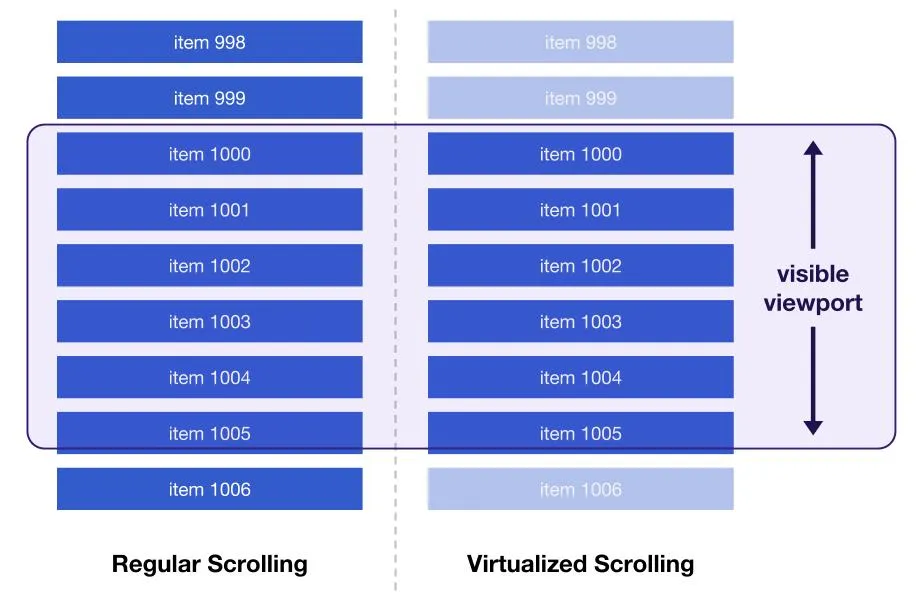In React, displaying lists of data is one of the most fundamental and essential skills every developer must master. From product lists on e-commerce sites, blog post lists, to social media feeds, it all comes down to one common technique: rendering a list.

This article will take you from the basics to performance optimization techniques, helping you not only "know how" but "do it best" when handling lists in React.
Rendering Lists: The "Magic" of the map Loop
Forget about traditional for or while loops in JavaScript. With React, our mindset is declarative. We don’t tell the computer "how" to draw each item, we just describe "what" should be displayed. The most powerful tool for this is the Array map() method.
The map() method iterates over each element of an array and returns a new array containing the result of executing a function on each element. In React, this new array is a list of React elements (JSX) ready to be rendered.
Classic example:
Imagine you have an array of superheroes:
const heroes = [
{ id: 1, name: 'Iron Man' },
{ id: 2, name: 'Captain America' },
{ id: 3, name: 'Thor' },
]
To render this list in a component, just map over it:
function HeroList() {
const heroes = [
{ id: 1, name: 'Iron Man' },
{ id: 2, name: 'Captain America' },
{ id: 3, name: 'Thor' },
]
return (
<ul>
{heroes.map((hero) => (
<li key={hero.id}>{hero.name}</li>
))}
</ul>
)
}
Analysis:
- We use curly braces
{}to embed JavaScript expressions in JSX. heroes.map(...)iterates over theheroesarray.- For each
hero, we return an<li>element with their name. - The result: React renders a
<ul>list with three<li>items.
The key Prop: More Than Just a Regular Prop
Did you notice the key={hero.id} prop above? This is not something you can ignore. The key prop is vital for React to identify, update, and optimize list rendering.
When a list changes (items are added, removed, or reordered), React needs a way to know which items changed, which are new, and which were removed. The key is the "ID card" for each list item.
Why is key so important?
- Performance: With
key, React can use its "diffing" algorithm efficiently. Instead of destroying and recreating the entire DOM list on every change, React only moves, updates, or removes the actual changed DOM elements. This greatly speeds up rendering, especially for large lists. - State preservation: If your list items are components with their own state (e.g., a checked
checkbox), providing a stablekeyensures the state stays with the correct item even if the list order changes. Without a stablekey, you may encounter hard-to-debug state bugs.
How to choose the right key?
- Best: Use a unique and stable ID from your data (e.g.,
product.id,user.id). This is ideal. - Acceptable (in special cases): If your data has no ID, you can generate a temporary one. Just make sure it doesn’t change between renders.
- Avoid: Using the array index as the key (
map((item, index) => <li key={index}>...)) is an anti-pattern. If the list is reordered or items are added/removed at the start/middle, indexes change, causing React to misidentify items and possibly break state and performance. Only use index as key if you are 100% sure the list is static and never changes order.
Advanced Techniques and Real-World Scenarios
1. Extracting Child Components
When each list item gets complex, keeping all logic in one component becomes messy. This is when you should extract child components.
// ListItem.js
function ListItem({ item }) {
return (
<li>
<h3>{item.title}</h3>
<p>{item.description}</p>
</li>
)
}
// ParentList.js
function ParentList({ items }) {
return (
<ul>
{items.map((item) => (
<ListItem key={item.id} item={item} />
))}
</ul>
)
}
Important note: key must be set on the component being mapped (<ListItem />), not inside the child component (<li> in ListItem.js).
2. Conditional Rendering in Lists
Sometimes you only want to show items that meet a certain condition. You can combine filter() with map().
function ActiveUsersList({ users }) {
return (
<ul>
{users
.filter((user) => user.isActive)
.map((user) => (
<li key={user.id}>{user.name}</li>
))}
</ul>
)
}
Or render different content based on a condition right inside map():
{
items.map((item) => (
<li key={item.id}>
{item.name}
{item.isNew && <span> (New!)</span>}
</li>
))
}
3. Handling Empty Lists
A good user experience is when your app tells users when there’s no data to display.
function ItemList({ items }) {
if (items.length === 0) {
return <p>No items to display.</p>
}
return (
<ul>
{items.map((item) => (
<li key={item.id}>{item.name}</li>
))}
</ul>
)
}
4. Performance Optimization for Large Lists: "Windowing"
If you need to render hundreds, thousands, or even tens of thousands of items, rendering them all at once will make your app extremely slow. The solution is windowing or virtualized lists.
The idea is simple: only render the items actually visible in the user’s viewport, plus a few buffer items above and below. As the user scrolls, swap out rendered items for new ones.

Popular libraries for this include:
- React Window
- React Virtualized
- TanStack Virtual (newer and more modern)
Using these libraries can dramatically improve performance and user experience for apps with large data sets.
Conclusion: Rendering Lists is More Than Just Making It Work
Rendering lists is a daily task for React developers. By mastering map(), understanding the importance of key, and knowing when to use advanced techniques like extracting components or windowing, you’re not just writing code that works—you’re building fast, smooth, and scalable apps.
Good luck on your React journey!

![[React Basics] useCallback and useMemo: Mastering React App Performance Optimization](/images/blog/usecallback-and-usememo.webp)
![[React Basics] Code Splitting: The Must-Know Performance Optimization Technique](/images/blog/code-splitting-in-react.webp)
![[React Basics] Form Handling in React: Master State, Controlled Components, and Validation](/images/blog/form-handling-in-react.webp)